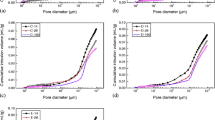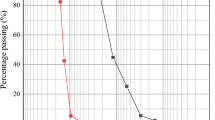Abstract
The findings of an experimental study are described, documenting and quantifying the influence of concrete porosity on its mechanical properties in saturated and dry states. Concrete porosity consists of capillary and entrained air, and described respectively as active and non-active, depending on its influence on mechanical properties with changing moisture state. It was found that the active (capillary) porosity influence on mechanical properties is more pronounced with decreasing moisture. The influence of non-active (entrained-air) porosity on concrete mechanical properties is invariant of moisture state.
Résumé
Les principaux résultats d'une étude visant à quantifier l'influence de la porosité sur les propriétés mécaniques du béton (à l'état sec et saturé) sont présentés. La, porosité du béton consiste en des pores capillaires et des vides d'air entraîné, qui sont respectivement décrits comme actifs et non-actifs selon leur influence sur les propriétés mécaniques du béton testé à différents degrés de saturation. Les résultats des essais démontrent que l'influence des pores capillaires (actifs) est inversement proportionnelle au degré de saturation du béton. Les effets des vides d'air entraîné (non-actifs) apparaissent comme étant peu sensibles au degré de saturation du matériau.
Similar content being viewed by others
References
Feldman, R. F. and Sereda, P. J., ‘A model for hydrated Portland cement paste as deducted from sorption-length change and mechanical properties’,Mater. Struct. 1 (6) (1968) 509–520.
Feldman, R. F. and Sereda, P. J., ‘A new model of hydrated cement and its practical implications’,Engineering Journal 53 (1970) 53–59.
Feldman, R. F., ‘Density and porosity studies of hydrated Portland cement’,Cement Technology 3 (1) (1972) 5–14.
Hearn N., ‘Saturated permeability of concrete as influenced by cracking and self-sealing’, (Ph.D. Thesis, University of Cambridge, UK, 1992).
Hearn N., ‘Comparison of water and propan-2-ol permeability in mortar specimens’,Advances in Cement Research 8 (30) (1996) 81–86.
Hearn N., Hooton, R. D. and Mills R. H., ‘Pore structure and permeability’, in ‘Significance of Tests and Properties of Concrete and Concrete Making Materials’, (ASTMSTP-169B, 1994).
Mills, R. H., ‘Gas and water permeability of concrete for reactor buildings-small specimens’, Research, Report INFO 0188-1, (Atomic Energy Control Board, Ottowa, Canada 1986).
Nilsen, A. U. and Monteiro, P. J. M., ‘Concrete: a three phase material’,Cement and Concrete Research 23 (1993) 147–151.
Powers, T. C. and Brownyard, T. L., ‘Studies of the physical properties of hardened Portland cement paste’,Journal of American Concrete Institute 43 (1947).
Powers, T. C., ‘Structure and physical properties of hardened Portland cement paste’,Journal of American Ceramic Society 41 (1958) 1–6.
Rossi, P., ‘Influence of cracking in the presence of free water on the mechanical behaviour of concrete’,Magazine of Concrete Research 43 (154) (1991) 53–57.
Swamy, N. and Rigby, G., ‘Dynamic properties of hardened paste, mortar, and concrete’,Materials and Structures—Research and Testing 4 (19) (1991) 13–40.
Yaman, I. O., Aktan, H. and Hearn, N., ‘Active and non-active pore structure of concrete—Part II: Evaluation of existing models’,Mater. Struct.,35 (246) (2001) 110–116.
Yaman, I. O., Udegbunam, O. and Aktan, H. M., ‘Assessing concrete permeability from ultrasonic pulse velocity measurements’, (Proceedings of the 79th Annual Meeting of Transportation Research Board in CD-ROM, Paper No.: 001190, 2000).
Zimmerman, R. W., King, M. S. and Monteiro, P. J. M., ‘The elastic moduli of mortar as a porous-granular material’,Cement and Concrete Research 16 (1986) 239–245.
Author information
Authors and Affiliations
Additional information
Editorial Note Dr. Nataliya Hearn is a RILEM Affiliate Member.
Rights and permissions
About this article
Cite this article
Yaman, I.O., Hearn, N. & Aktan, H.M. Active and non-active porosity in concrete Part I: Experimental evidence. Mat. Struct. 35, 102–109 (2002). https://doi.org/10.1007/BF02482109
Received:
Accepted:
Issue Date:
DOI: https://doi.org/10.1007/BF02482109




